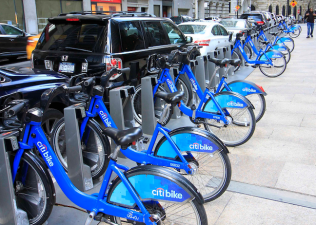Friday’s Headlines: The Treachery of Images Edition

I took a ride yesterday from Jackson Heights to Forest Hills and then to Tribeca, and though it was a gorgeous day, at the end of the 13-mile voyage, I went up to the office, threw down my bag and asked my non-responsive co-workers, “Why does biking in New York City have to be so unpleasant?”
The answer would fill volumes, so I’ll just limit myself to one part of it: Why is Queens Boulevard labeled as a protected bike lane on the city’s official bike map (see below)?

Sure, the roadway is painted green. But a cyclist is not protected in most stretches of the westbound lane by anything except paint. Yes, sometimes there are knocked-down plastic pylons. But those damaged totems of futility aren’t protection either.
Don’t get me wrong — it’s a great ride. But a protected bike lane, this is not:

Well, it obviously wasn’t just my personal pet peeve that inspired me to make the Rene Magritte poster that you see atop this post (hey, college freshmen, order one today for your dorm room!).
On Thursday night, as luck would have it, the Queens Community Board 6 Transportation Committee got a briefing from the DOT on its Queens Boulevard efforts. Apparently, the city knows ceci n’est pas une piste cyclable protégée, so it’s going to do a better job going forward, as the committee co-chair Peter Beadle tweeted afterwards:
And the answer is that they are still in the middle of installing the barriers and quick curb and will be doing QB in both directions.
— ?Peter W Beadle? (@pwbnyc) October 28, 2022
He even said that on his ride home, he saw workers installing “heavy plastic bollards they call quick curb in several of the big gaps.” He’s optimistic. We’ll be watching.
Now, get set for the weekend with all the news you need:
- The best story yesterday was John Surico’s Hell Gate piece on the failure of the suburbs to build transit-oriented development, despite being the beneficiaries of a massive expansion of Metro-North and LIRR service.
- In a related story — a very related story — home prices in the Long Island suburbs are up, despite a national downward trend. The reason? If you don’t build enough housing, the existing housing gets more expensive. (NY Post)
- Oh, and speaking of housing, New York City lawmakers aren’t much better. Yesterday, a Council committee approved a rezoning for the Gowanus section of Brooklyn — but only after the number of affordable units was slashed. That looks like a bad movie by Council Member Shahana Hanif, who co-chairs the Council’s progressive caucus. (The City, Crain’s, New York Focus)
- Read all about a Queens tow truck operator who has been dumping cars near St. Michael’s Cemetery for years. (The City)
- We had a nice scoop yesterday about a nice federal grant that the city EDC received to boost maritime freight, which sounds dull, but it’s basically the key to getting our streets back.
- Two truckers slammed into each other — and at least one was obviously speeding. (Upper East Site)
- The Post website was hacked when a rogue employee put up lurid, racist, sexist GOP-themed stories (wait, are we sure that was a hack?). (NYDN)
- A lot of outlets are doing their “Hurricane Sandy: 10 Years Later” stories. The City focused on resiliency (“You might want to get a snorkel”) and on why the city allowed so many new units in once-flooded Coney Island. Stephen Nessen at Gothamist focused on the Gateway Tunnel project. That was also a part of Dave Colon’s sprawling overview of all the transportation shortfalls that make us ill prepared for Sandy II. (Streetsblog)
- We know the city is rightly tearing down dining sheds that are abandoned or have become trash piles, but Pinky’s Space was neither. Oops. (NY Post)
- Four Buffalo teens were killed racing a Kia. (NY Post)
- Greenway lovers took a victory lap by passing a Council bill mandating a master plan. (amNY)
- The Council passed a rat action plan. (NYDN, PoliticsNY)
- And, finally, on the subway’s 118th birthday, New York City Transit President Richard Davey did the right thing by a woman with a baby stroller. I’m guessing that Davey isn’t available at every single station, so he’s going to have to do the next best thing: install working elevators at every station.
The NYC Subway turns 118 today! To mark the occasion @MTA President Richard Davey is riding the system in the Bronx, Queens & Manhattan today. He stared the morning helping this woman & her baby down the stairs bc the elevator at 161 St-Yankee Stadium Station is broken. @NY1 pic.twitter.com/oedVNZZE7g
— Alyssa Paolicelli (@APaolicelli17) October 27, 2022
